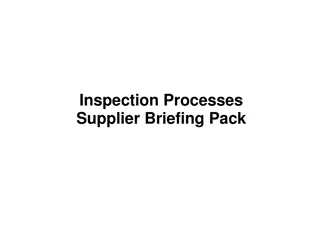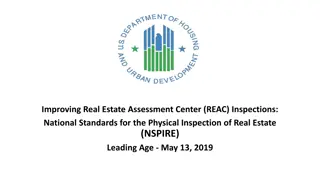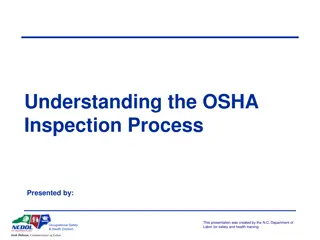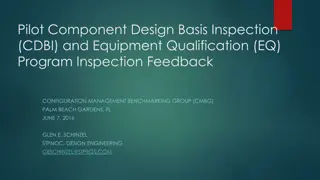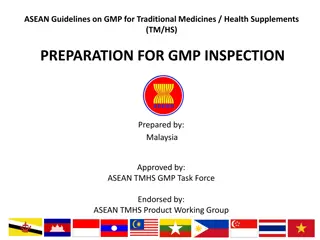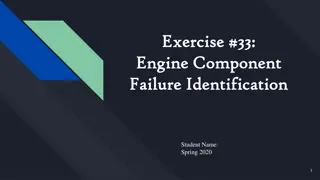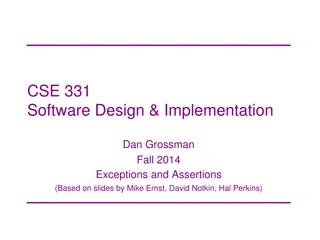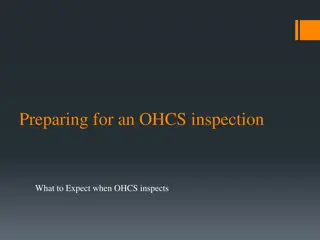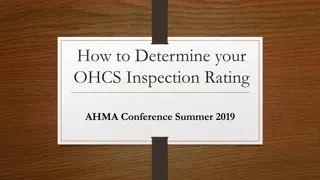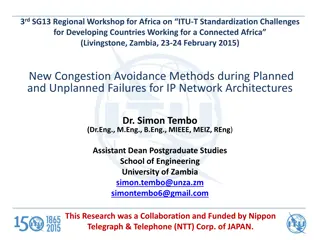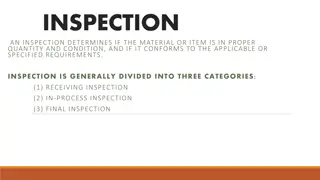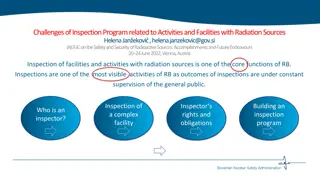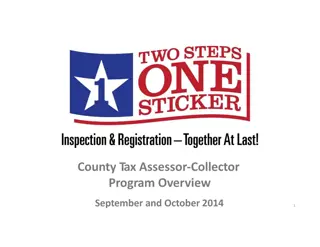Common Robot Inspection Failures and How to Avoid Them
Discussion of common issues observed during robot inspection, such as bag and tag procedures, weight management, size limits, and bumper requirements. Tips provided on avoiding these failures and preparing for inspection effectively.
Download Presentation

Please find below an Image/Link to download the presentation.
The content on the website is provided AS IS for your information and personal use only. It may not be sold, licensed, or shared on other websites without obtaining consent from the author. Download presentation by click this link. If you encounter any issues during the download, it is possible that the publisher has removed the file from their server.
E N D
Presentation Transcript
10 Quick and Easy Ways to Fail Inspection ( and how to avoid them) Presented by: Mark Moulton - 2977 Lead Robot Inspectors Lake Superior, North Star, 10k Lakes mark.moulton@isd300.k12.mn.us 2013 MN Splash
Overview: A discussion of some of the most common problems observed during robot inspection Rules are subject to change each year, so I have avoided using specific numbers, etc. as much as possible
0) Bag and Tag Lock the robot up on time Fill out the form completely every box on each row needs to be filled out! Bring the B&T form with you when you drop off the robot the inspectors will check it before the pits open Thursday morning Do NOT duct tape it directly to your bag tape a page protector to the bag so the form can be easily removed and signed off on a flat surface 2012 MN Splash
1) Weight Contrary to what some teams seem to believe, there is a weight limit! It is much, much easier to manage weight as part of your design than it is to try and remove it later It is far easier to drill holes in a part before it is assembled onto the robot than to try to do it at the competition Have someone responsible for allocating the weight budget to the various subsystems on the robot, and track the weight of each piece Use the capabilities of your 3D CAD software If you want to be at max weight, it s far easier to add weight at competition than remove it! Buy a good scale!!!
2) Size There is a defined size limit, too!! The size definition drastically changed last year Prior to 2013, there was a max width and length for the robot In 2013, there was a maximum frame perimeter measurement Build your robot 1 under size in every dimension Robots can be re-checked at any time, so make sure your design is robust enough to not get bent out of shape
3) Bumpers Bumpers will be required again this year. Must be built to the requirements shown in the rules Use Plywood. Not particle board, etc. Use two pool noodles. Not foam pipe insulation. Plywood must not extend more than 1 beyond the frame Covers need to be attached well. Sagging covers that hang below the Bumper Zone can result in penalties. Bumpers have their own weight limit, and are weighed separately from the robot Must be rigidly attached to the robot Bumpers have to come off the robot for sizing and weight As a guideline, Bumpers should be removable and installable by one person in less than 10 minutes Good looking bumpers help make a good looking robot!
4) Sharp Edges Inspectors will be looking for sharp corners and edges that could cause injury, pinch points, entanglement hazards, and impaling projections. Please mitigate all such hazards. This is for the protection of team members and field personnel as well as game equipment. Debur all cut metal edges, especially outside corners. Same for cut plastic edges. Use care when cutting plastic cable ties (zip-ties) to avoid leaving a pointed, protruding end. Cut them square and flush, or file them down.
5) Bill of Materials (BoM) You have to have one With you, to show to the inspector, not back at the hotel They will not be collected, but will be reviewed and compared to your robot during inspection. List everything you used in the robot Even if it came in the Kit of Parts. Use $0 for the cost. Even if it was donated. Use what it would cost if you had bought it. Do not need to include fasteners, etc, that cost < $1 Don t include stuff that is not part of the robot: Tools, Buttons, Food, Driver Station Parts, etc. This is also a good place to keep track of your weight! These actually get looked at by the inspectors!
6) Team Name / Number / Sponsors This is one of the leading causes of teams failing inspection!! The team number must be on all 4 sides of the robot, using numbers that are at least the height and stroke width specified in the rules. This is so the announcers can identify your robot! Will be required to be on the bumpers again Pay attention to any rules regarding colors, backgrounds, and splitting of numbers! The name of the school (or sponsoring organization) and your primary sponsors need to be on the robot. These are the people who paid for your robot, be proud of them and give them the appropriate credit!
7) Electrical Make sure the battery is securely fastened in place Even when the robot tips over Insulate your battery terminals Use the appropriate size and color wires, per the rule requirements Only use the allowable motors from This Year s Kit of Parts Use only the number allowed by the rules
7) Electrical The electrical system must be isolated from the robot frame The cRIO and the camera both have internal connections between the mounting holes and the power return! They must be mounted with a non-conductive material between them and the robot frame. This is checked at inspection by measuring the resistance between the battery cable terminals and the frame with an ohmmeter I strongly recommend labeling the circuit breakers and wires. Make sure you have adequate strain relief, and make sure wires will not fall out of connectors (especially PWM cables)
8) Radio & Robot Signal Light The Robot Signal Light (Orange Blinky Light) must be placed such that it is visible from in front of the robot The light must be wired correctly: There needs to be a jumper wire between the La and Lb terminals for the light to work properly Fast Blink: System Error / No Communications Steady On: Everything OK Fast - Slow Blink: Low Battery and System Disabled Slow Blink: System Disabled
8) Radio & Robot Signal Light Connect the radio properly using the DC-DC converter module (silver hockey puck looking thing), not directly to the Power Distribution board. Connect the DC-DC converter to the regulated output on the Power Distribution Board
9) Pneumatics (Air Compressor) Improper operation of the air compressor is one of the most common problems observed at inspection. The pressure sensor switch must be wired to the cRIO Digital Sidecar, not to the compressor The cRIO must control the compressor by software, using a Spike Relay This is so that when the robot is disabled, the compressor is also disabled The compressor must shut off at < 125 psi It is highly recommended to replace the 20A fuse in the Spike relay with a 20A circuit breaker
9) Pneumatics Do not use more than the number (and type) of pressure storage tanks allowed in the rules The pressure relief valve provided in the KoP must be attached directly to the compressor. It must be set to the appropriate vent pressure. There must be an easily accessible vent valve, that vents the entire pneumatic system. It must be on the high pressure part of the system. All pneumatic components must meet the minimum pressure rating given in the rules DO NOT MODIFY ANY PNEUMATIC COMPONENT, except as may be specifically allowed in the rules. This includes painting!!!
10) Firmware Versions The cRIO must have the correct (latest) firmware image loaded If it is necessary to update the cRIO at the competition, you will also have to load the latest set of libraries for whatever programming environment you are using, and re-compile. If you are using CAN with the Jaguar speed controllers, they must be programmed with the latest firmware version The Driver Station must have the correct (latest) version installed
Summary The inspection checklist will be released prior to Stop Work Day. Use it to pre-inspect your robot. The inspectors will only talk to students during the inspection, not mentors. Make sure your team members that know the answers to the questions are available when you come for inspection. The inspectors are there to help. If your robot has a problem, they will try to work with you to get it fixed, or help you find another team that can assist. Please help us out by not waiting until the last minute to get in line for inspection. A proper inspection takes 30-45 minutes.
Summary If you disagree with the inspector, please politely ask to get a second opinion from the Lead Robot Inspector. The decisions of the Lead Robot Inspector are final. We will do everything we possibly can to make sure your robot passes inspection before your first match! Remember - the inspectors are your friend Any questions, feel free to contact me at Jonathan.Stratis@gmail.com


